The global LCR meters market is expected to grow from USD 809.3 million in 2025 to USD 1,152.6 million by 2035, reflecting a CAGR of 3.6%. This growth is driven by the increasing demand for precise measurement instruments in various industries, including electronics, automotive, and telecommunications.
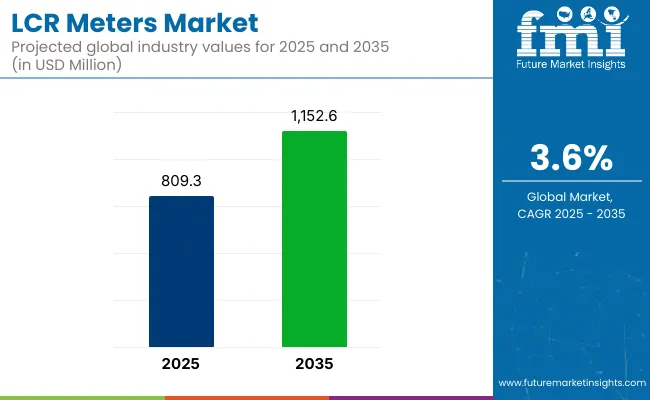
Advancements in LCR meter technologies, such as high-accuracy measurements, compact designs, and automated testing features, are contributing to market expansion. The rising adoption of LCR meters for quality control, R&D, and product testing, along with the growing need for advanced measurement tools in manufacturing processes, further fuel the market’s growth.
Innovations in LCR meters have significantly enhanced their performance and applicability across various industries. Modern devices now offer extended frequency ranges, with some models capable of measuring from 4 Hz to 10 MHz, enabling precise testing of components across a broad spectrum.
Advanced features such as automated component identification, real-time data logging, and seamless integration with cloud platforms facilitate efficient quality control and research processes. Additionally, the incorporation of wireless connectivity options like Bluetooth and Wi-Fi allows for remote monitoring and data analysis, improving operational flexibility and user convenience.
Government regulations play a crucial role in ensuring the quality, safety, and standardization of LCR meters. In India, for instance, the Government e-Marketplace (GeM) mandates compliance with specific technical specifications and safety standards for LCR meters procured through public tenders. Internationally, LCR meters are required to adhere to safety standards such as IEC 61010-1, which outlines safety requirements for electrical equipment for measurement, control, and laboratory use.
Germany is expected to be the fastest-growing market for LCR meters, with a projected CAGR of 4.2%. Handheld LCR meters will dominate the type segment, holding 45% of the market share by 2025. Quality control & inspection will lead the application segment with a 32% share. The USA and the UK are also expected to experience notable growth, with projected CAGRs of 4% and 3.5%, respectively.
The LCR meters market is segmented into type, measurement frequency, application, end use, and region. By type, the market is divided into handheld LCR meters, benchtop LCR meters, and portable LCR meters. In terms of measurement frequency, the market is categorized into low-frequency (up to 100kHz), mid-frequency (100kHz to 1MHz), and high-frequency (above 1MHz). Based on application, the market is segmented into component testing, quality control & inspection, research & development, and production testing.
By end use, the market is divided into automotive, consumer electronics, aerospace & defense, healthcare, telecommunications, and industrial manufacturing. Regionally, the market is classified into North America, Latin America, Western Europe, South Asia, East Asia, Eastern Europe, and the Middle East & Africa.
Handheld LCR meters are projected to lead the type segment, accounting for 45% of the global market share by 2025. These devices are preferred for their portability and ease of use in on-site testing, especially in the electronics industry.
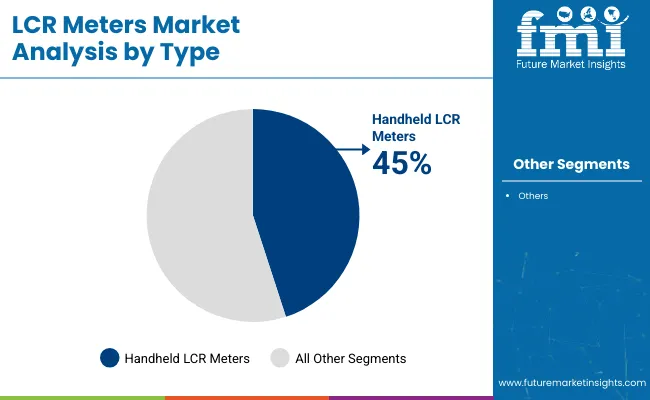
Low-frequency LCR meters are projected to lead the measurement frequency segment, accounting for 38% of the global market share by 2025. These meters are used to test passive components like resistors, capacitors, and inductors in low-frequency power supply applications.
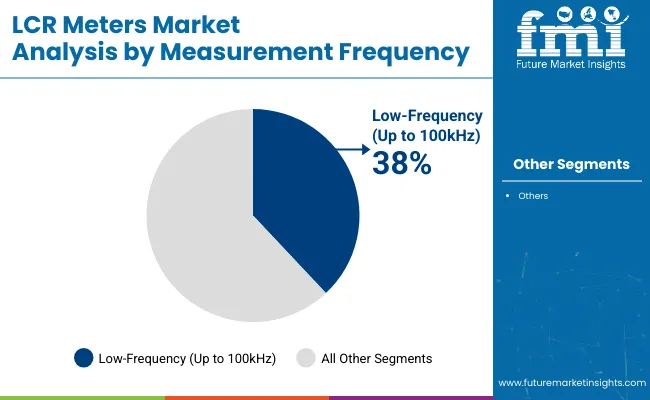
Quality control & inspection is expected to dominate the application segment, securing 32% of the global market share by 2025. This is due to the growing need for accurate testing of components in various manufacturing processes to ensure compliance with standards.
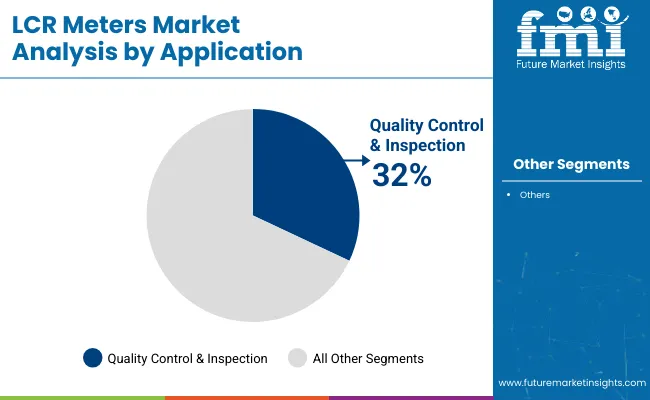
The automotive sector is anticipated to dominate the end-use segment, accounting for 27% of the global market share by 2025. The demand for LCR meters in automotive manufacturing is driven by the increasing complexity of electrical systems in modern vehicles.
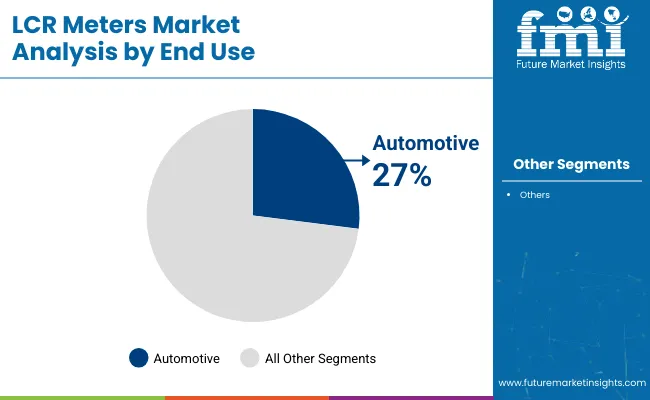
The global LCR meters market is experiencing steady growth, driven by the increasing demand for precision measurement tools in industries such as electronics, automotive, and telecommunications. These devices are crucial for testing and validating components used in manufacturing and quality control.
Recent Trends in the LCR Meters Market
Challenges in the LCR Meters Market
The global LCR meters market is experiencing steady growth, driven by the increasing demand for precision measurement tools in industries such as electronics, automotive, and telecommunications. LCR meters are essential for testing and validating components in manufacturing and quality control processes.
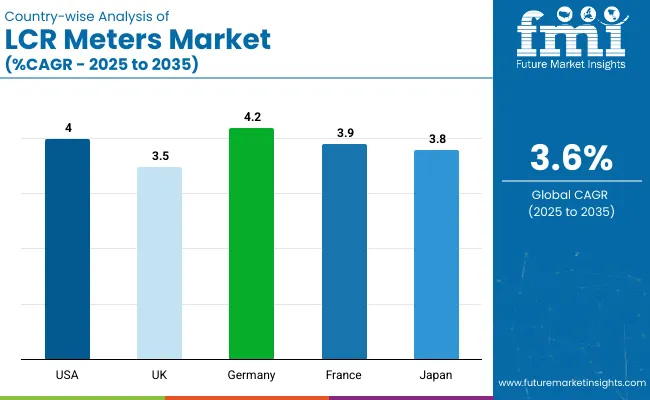
The sales of LCR meters in the USA are expected to grow at a CAGR of 4% from 2025 to 2035. This growth is driven by the rising demand for LCR meters in the electronics, automotive, and telecommunications sectors.
The UK LCR meters revenue is projected to grow at a CAGR of 3.5% from 2025 to 2035, supported by the country’s strong presence in the electronics and telecommunications industries.
Germany’s LCR meters demand is projected to grow at a CAGR of 4.2% from 2025 to 2035, driven by the country’s leadership in electronics manufacturing and automotive innovation.
The French LCR meters market is expected to grow at a CAGR of 3.9% from 2025 to 2035, driven by the country's robust electronics and automotive industries.
Japan's LCR meters revenue is expected to grow at a CAGR of 3.8% from 2025 to 2035, driven by the demand for advanced precision testing tools in the automotive, consumer electronics, and telecommunications sectors.
The LCR meters market is moderately consolidated, with leading players such as Keysight Technologies, Rohde & Schwarz, Hioki E.E. Corporation, Fluke Corporation, and B&K Precision Corporation. These companies dominate by offering advanced and precise measurement systems tailored to industries like electronics, automotive, and telecommunications.
For instance, Keysight Technologies provides high-accuracy LCR meters ideal for R&D and manufacturing applications, while Rohde & Schwarz is known for its advanced LCR meters with wide frequency ranges, perfect for automotive and telecommunications testing. Hioki E.E. Corporation excels in offering cost-effective LCR meters widely used in industrial applications, and Fluke Corporation leads with handheld LCR meters for field testing and industrial environments.
Recent LCR Meters Industry News
In July 2024, Hioki expanded its production capacity by transferring some activities to the newly operational Ueda Factory II. The facility will focus on developing, producing, and selling automatic test equipment, meeting rising demand for testing semiconductor package boards in AI applications.
| Report Attributes | Details |
|---|---|
| Market Size (2025) | USD 809.3 million |
| Projected Market Size (2035) | USD 1,152.6 million |
| CAGR (2025 to 2035) | 3.6% |
| Base Year for Estimation | 2024 |
| Historical Period | 2020 to 2024 |
| Projections Period | 2025 to 2035 |
| Report Parameter | USD million for value/Volume in billion units |
| Type Analyzed | Handheld LCR Meters, Benchtop LCR Meters, and Portable LCR Meters |
| Measurement Frequency Analyzed | Low-Frequency (Up to 100kHz), Mid-Frequency (100kHz to 1MHz), and High-Frequency (Above 1MHz) |
| Application Analyzed | Component Testing, Quality Control & Inspection, Research & Development, and Production Testing |
| End Use Analyzed | Automotive, Consumer Electronics, Aerospace & Defense, Healthcare, Telecommunications, and Industrial Manufacturing |
| Regions Covered | North America, Latin America, Western Europe, South Asia, East Asia, Eastern Europe, Middle East & Africa |
| Countries Covered | United States, Canada, United Kingdom, Germany, France, China, Japan, South Korea, Brazil, Australia |
| Key Players Influencing the Market | Keysight Technologies, Rohde & Schwarz, Hioki E.E. Corporation, Fluke Corporation, B&K Precision Corporation, GW Instek, Extech Instruments, Applent Instruments, Wayne Kerr Electronics, Chroma ATE Inc. |
| Additional Attributes | Dollar sales growth by product type, regional demand trends, competitive landscape, technological innovations |
The market is segmented into Handheld LCR Meters, Benchtop LCR Meters, and Portable LCR Meters.
The industry is divided into Low-Frequency LCR Meters (Up to 100kHz), Mid-Frequency LCR Meters (100kHz - 1MHz), and High-Frequency LCR Meters (Above 1MHz).
The market caters to Component Testing, Quality Control & Inspection, Research & Development, and Production Testing.
The report covers key sectors, including Automotive, Consumer Electronics, Aerospace & Defense, Healthcare, Telecommunications, and Industrial Manufacturing.
The report covers key regions, including North America, Latin America, Western Europe, Eastern Europe, East Asia, South Asia, and the Middle East & Africa (MEA).
The market is valued at USD 809.3 million in 2025.
The market is forecasted to reach USD 1,152.6 million by 2035, reflecting a CAGR of 3.6%.
Handheld LCR meters will lead the market by type, accounting for 45% of the global market share in 2025.
The quality control & inspection segment will dominate the market with a 32% share in 2025.
Germany is projected to grow at the fastest rate, with a CAGR of 4.2% from 2025 to 2035.






Full Research Suite comprises of:
Market outlook & trends analysis
Interviews & case studies
Strategic recommendations
Vendor profiles & capabilities analysis
5-year forecasts
8 regions and 60+ country-level data splits
Market segment data splits
12 months of continuous data updates
DELIVERED AS:
PDF EXCEL ONLINE
Multi-fulcrum Suspension Crane Market Size and Share Forecast Outlook 2025 to 2035
Ammeters Market Size and Share Forecast Outlook 2025 to 2035
Ergometers Market Size and Share Forecast Outlook 2025 to 2035
Rheometers Market Size and Share Forecast Outlook 2025 to 2035
Gas Meters Market Growth - Trends & Forecast 2025 to 2035
Manometers Market
Micrometers Market Size and Share Forecast Outlook 2025 to 2035
Viscometers Market Size and Share Forecast Outlook 2025 to 2035
Flow Meters Market Growth - Trends & Forecast 2025 to 2035
Megohmmeters Market Size and Share Forecast Outlook 2025 to 2035
Calorimeters Market Size and Share Forecast Outlook 2025 to 2035
Gloss Meters Market
Luminometers Market
Refractometers Market Growth – Trends & Forecast 2018-2027
Turbidity Meters Market Size and Share Forecast Outlook 2025 to 2035
Inductance Meters Market Size and Share Forecast Outlook 2025 to 2035
Pocket Pedometers Market
Dial Thermometers Market
Spectrophotometers Market Size and Share Forecast Outlook 2025 to 2035
Bone Densitometers Analysis by Product Type, by Technology and by End User through 2035

Thank you!
You will receive an email from our Business Development Manager. Please be sure to check your SPAM/JUNK folder too.
Chat With
MaRIA